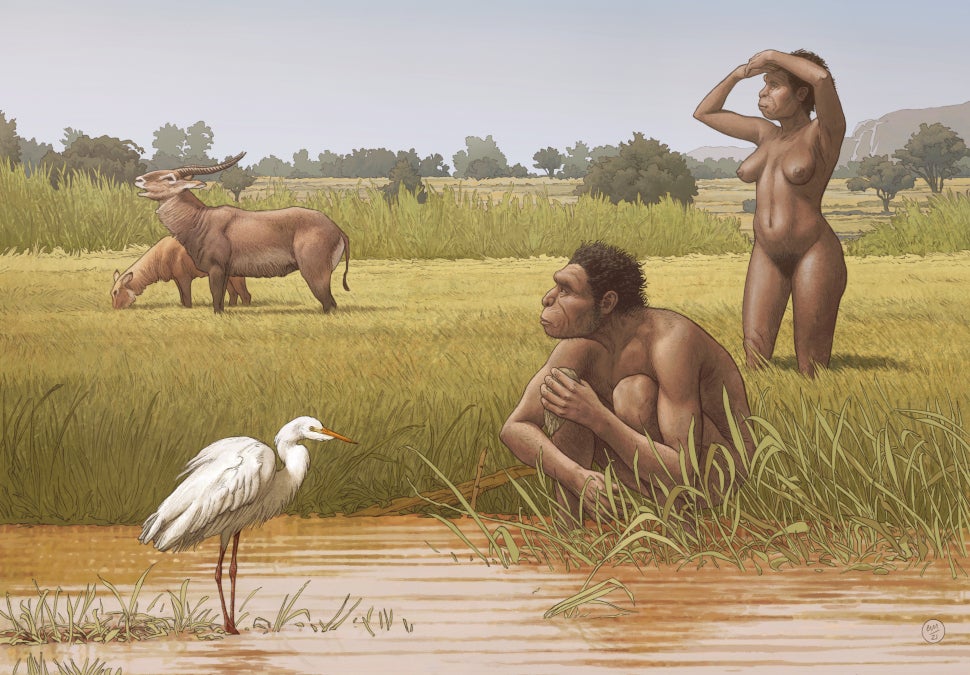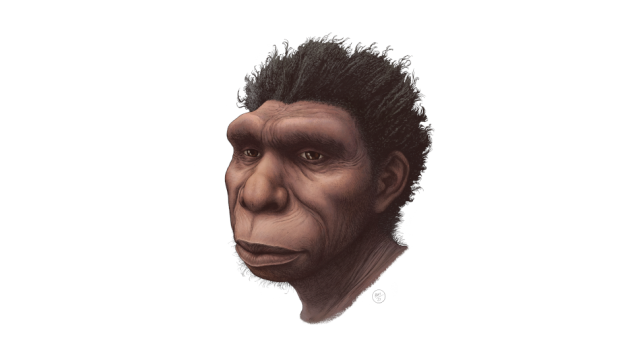The chronicling of human evolution has proven to be an onerous and complicated task, resulting in all sorts of contradictions and inconsistencies. A group of scientists is seeking to make better sense of this anthropological mess by proposing a new species of ancestral human that calls for the reassigning of certain fossils.
Anthropologists call it “the muddle in the middle” — that pesky period in human evolutionary history that’s littered with far too many question marks. Indeed, the Middle Pleistocene, also known as the Chibanian (774,000 to 129,000 years ago), represents a key transitional stage for the human genus, or Homo, yet this period remains poorly understood. That’s a shame, because it was during the Chibanian that our species, Homo sapiens, emerged some 300,000 years ago.
Much of the muddle in the middle has to do with the poor fossil record. Our ancestors didn’t leave much of themselves behind, and the few fossils they did leave tell an incomplete story. Outdated scientific conventions, weak terminology, and an unwillingness to respond to new scientific data have also added to the muddle, according to new research published in Evolutionary Anthropology Issues News and Reviews
The new paper seeks to clear much of this fog by declaring a new taxon, or species, of ancestral human: Homo bodoensis. This species is not based on any new fossil discovery but is instead a reworking of pre-existing fossils found in Africa and Eurasia, all of which date back some 700,000 to 500,000 years ago. The new name has been added to the Zoobank of the International Commission on Zoological Nomenclature (ICZ), making it “official,” in the words of anthropologist Mirjana Roksandic from the University of Winnipeg.
“Whether it lives or goes into oblivion is a matter of whether people working in the field find it to be a useful tool for communication, scenario building, or hypothesis testing,” Roksandic, who led the study, explained in an email. “We firmly believe that it will stick.”

All fossils assigned to H. bodoensis are traditionally assigned to one of two ancestral human species: Homo heidelbergensis or Homo rhodesiensis. Trouble is, these two species, as taxonomic classifications, are currently very messy, as they carry multiple and contradictory definitions and aren’t fully defined by a strict set of criteria, the scientists argue.
“Recent developments in the field of palaeoanthropology necessitate the suppression of two hominin taxa and the introduction of a new species of hominins to help resolve the current nebulous state of Middle Pleistocene (Chibanian) hominin taxonomy,” the authors write in their study. “In particular, the poorly defined and variably understood hominin taxa Homo heidelbergensis…and Homo rhodesiensis need to be abandoned as they fail to reflect the full range of hominin variability in the Middle Pleistocene.”
The scientists raise some important issues. Anthropologists have lumped some H. heidelbergensis and H. rhodesiensis African fossils together, which is obviously not cool and a sign that something’s askew. As an aside, many anthropologists dislike the term “rhodesiensis,” as it’s (partly) named for Cecil Rhodes — a controversial imperialist politician who presided over the deaths of thousands of Africans in the late 19th century (more on this in a bit). Roksandic and her colleagues reassigned nearly all H. rhodesiensis fossils to H. bodoensis, with some added to H. sapiens.

H. heidelbergensis is also problematic, said Roksandic, because it’s a “one size fits all species” and “many different fossils were included in it.” All Chibanian fossils were included at one time or another into H. heidelbergensis sensu lato, meaning they were added in the broad sense, she said. Simply put, “most of the H. heidelbergensis fossils from Europe are early Neanderthals,” which has been “suspected based on morphology for a long time” and recently confirmed by a DNA study of the Spanish Sima de los Huesos fossils, she explained.
“Other H. heidelbergensis fossils, especially those with a ‘sensu lato’ qualifier, could be part of H. bodoensis,” especially fossils found in the eastern Mediterranean, she added. As for fossils found in east Asia, those are a “different” and “still unresolved issue,” said Roksandic. Accordingly, east Asian fossils assigned to H. heidelbergensis should be removed from this category, as they “likely represent a different lineage altogether,” as the authors write in the paper.
The newly described species, H. bodoensis, is based on a skull found in 1976 in Bodo D’ar Ethiopia that’s thought to be a direct ancestor of H. sapiens. The Bodo cranium is currently assigned to H. heidelbergensis. H. bodoensis had a big brain and enlarged braincase, which likely allowed these early humans to live in all sorts of challenging environments, including those altered by rapidly changing climates. The defining of new species offers some “clear advantages,” as the scientists write in their study:
[It] recognises the variability and geographic distribution of Middle Pleistocene hominins; and…it describes the unique morphology of the African Middle Pleistocene hominins that extends into the eastern Mediterranean that is distinct from H. neanderthalensis and predates the appearance of H. sapiens. While not a true species in the strict biological sense (since there is strong and growing evidence of migrations as well as gene flow between these diverged groups) this newly defined taxon cuts through the obfuscating and inconsistent use of improperly named and defined Middle Pleistocene hominins in Europe and Africa and should facilitate more consistent and meaningful discussions around these various topics presented here.
As the authors note, H. bodoensis is still not a true, ironclad species, given the significant amount of interbreeding that happened between different human groups and the highly mobile nature of early humans. As previous research shows, human populations didn’t evolve from a single ancestral population.
Chris Stringer, an anthropologist at the Natural History Museum of London who wasn’t involved in the new research, expressed some concerns with the new paper.
“I agree that heidelbergensis has been used as a rag-bag and I’m partly to blame for originating its wider usage — but I’ve never used it to include the Sima fossils,” he explained in an email. “It does need rethinking as a wider term because the Mauer mandible is so idiosyncratic, but under ICZN rules you can’t just cancel a species name you don’t like — there have to be pretty good reasons — and the distinctiveness of Mauer probably warrants keeping that name for it.”
The Mauer mandible was discovered in a German sand quarry in 1907 and is currently assigned to H. heidelbergensis. Roksandic and her colleagues want it reassigned to Homo neanderthalensis, but Stringer isn’t convinced the change is warranted given its unique characteristics.
At the same time, H. rhodesiensis, Stringer argues, is sufficient for what the scientists are trying to achieve, and he doesn’t see the need to create yet another name. The name rhodesiensis dates back to the Broken Hill/Kabwe cranium, discovered in 1921, which was named for the country of origin, Northern Rhodesia, now Zambia.
“But even if the rhodesiensis name is somehow suppressed, the correct thing would then be to look within the species group for the next appropriate given name,” Stringer said, recommending both “saldanensis” (after the Elandsfontein cranium found in 1955) and “cepranensis” (after the Ceprano fossil from 2003). Regardless, taxonomic names “wax and wane according to their usefulness and appropriateness in research, and the muddle will sort itself out given time,” he added.
Stringer says the proposed species, H. bodoensis, exhibits facial characteristics consistent with another archaic human, H. antecessor, so, again, he’s not entirely sure a new species needs to be declared at this time. What’s more, it’s already “generally accepted,” he said, that many apparent H. heidelbergensis fossils from western Europe should be assigned to Neanderthals. As for the Asian fossils representing a different lineage altogether, Stringer said that’s “exactly what we proposed in our paper on the Harbin cranium which unfortunately they do not cite.” The Harbin cranium, also known as Dragon Man, was described in research published earlier this year.
Looking ahead, Roksandic said her team will use the newly defined species to construct new hypotheses about their distribution and determine which existing fossils might fit into the taxon, in addition to “excavating and searching for fossil humans in the less well researched areas of the world,” she said.
As for the larger scientific community latching onto this idea, it may or may not happen. But as Stringer’s comments make abundantly clear, there’s still considerable disagreement on these matters. The muddle in the middle remains… muddled.
More: Move Over Neanderthals, Newly Discovered ‘Dragon Man’ Might Be Our True Sister Species.
